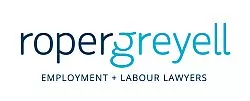This morning, Prime Minister Justin Trudeau announced a series of significant measures designed to help certain employers weather the storm of the COVID-19 pandemic. The Department of Finance also published a Backgrounder, which provides further detail on certain of these measures. While many of the key details are pending (we understand that further details are set to be released between now and Monday March 30, 2020), employers should be aware of these measures, and start to consider how these measures may impact their plans as they continue to navigate these challenging times. This memorandum briefly summarizes the elements of the Prime Minister's announcement and the Backgrounder which will be of significance to employers.
For further information relating to the COVID-19 pandemic and how it may impact your workplace, please look to our previous bulletins, which can be found on Roper Greyell's COVID-19 resource page.
This memorandum is current to the morning of March 27, 2020, but the pandemic and the responses of federal and provincial governments continue to evolve, and this may impact the accuracy of the information in this bulletin. If in doubt about whether anything in this document is still current, please do not hesitate to contact us.
The Federal Government Announcements
- Temporary Wage
Subsidy: In an effort to encourage employers to keep
employees on payroll, the Federal Government announced it is
increasing the limit on the previously announced Temporary Wage
Subsidy to 75% for qualifying small and medium sized businesses
("SMEs"), a substantial increase from the previously
announced 10% limit that was addressed in our our
March 19, 2020 Bulletin. The Federal Government has said that
this wage subsidy will be provided for up to 3 months and be
back-dated to March 15, 2020.
On this webpage, the CRA has indicated that employers who met the following eligibility criteria were eligible for the previously announced version of the Temporary Wage Subsidy: (i) non-profit organization, registered charity, or Canadian-controlled private corporation (CCPC); (ii) that has an existing business number and payroll program account with the CRA on March 18, 2020; (iii) that pays salaries, wages, bonuses, or other remuneration to an employee; and (iv) for CCPCs, has taxable capital employed in Canada for the preceding taxation year (calculation on an associated group basis) of less than$15 million.
Please note that it is not yet clear whether these criteria will continue to apply or will be modified in light of the increase to the subsidies provided, or whether certain business may remain eligible for the old subsidy program if they do not otherwise qualify for the new subsidy program. At the time of writing, CRA's website had not been updated to reflect the Federal Government's announcement of this morning. - Small Business Loans: The Federal Government also announced the Canada Emergency Business Account that will provide Government guaranteed loans of up to $40,000 for qualifying small businesses and not-for-profits which will be interest free for the first year. To qualify, these organizations will need to demonstrate they paid between $50,000 and $1 million in total payroll in 2019. Repaying the balance of the loan on or before December 31, 2022 will result in loan forgiveness of 25 percent (up to $10,000). The Backgrounder indicates that this program is worth $25 billion.
- Tax and Duty Relief: The Federal Government announced that GST and HST remittances, as well as customs duty and sales tax payments owed on imports, will be deferred until June 30, which the Backgrounder indicates amounts to up to $30 billion in cash flow or liquidity assistance for Canadian businesses and self-employed individuals over the next three months. Additional details are set out in the Backgrounder.
- Export Development Canada and Business Development Bank: The Federal Government has announced that that Export Development Canada and Business Development Bank will make additional capital available to assist qualifying SMEs.
In other contexts, the Federal Government has defined a small business as having 1-99 employees and a medium business as having 100-499 employees: https://www.ic.gc.ca/eic/site/061.nsf/eng/Home. It is unclear if these definitions will be used to determine eligibility for any or all of the programs detailed above, or whether new definitions will be put into place.
Further details of these plans have not been made public at the time of writing, but are expected to be released in the coming days.
Navigating COVID-19 in the Workplace
As with all of our previous COVID-19 updates, we caution that the pandemic and the responses of federal and provincial governments continue to evolve by the day and by the hour. We recognize that the guidance being provided by government authorities (and law firms) can be overwhelming. If you have any questions about any of these programs, or any questions at all about how your workplace should be addressing the COVID-19 pandemic, please do not hesitate to contact us.
The content of this article is intended to provide a general guide to the subject matter. Specialist advice should be sought about your specific circumstances.


